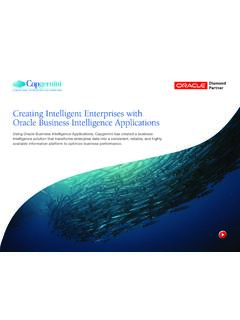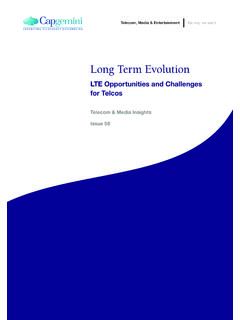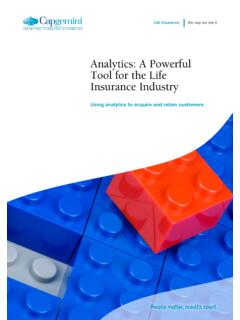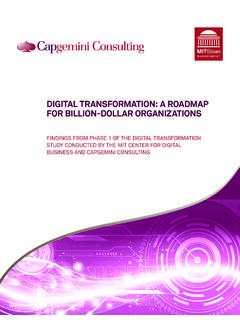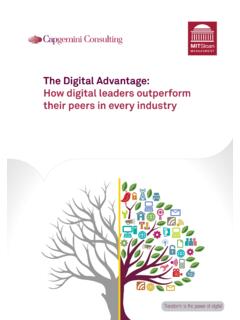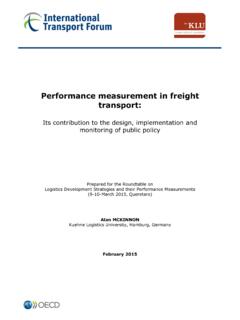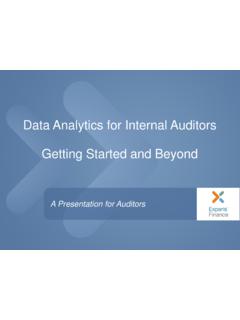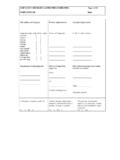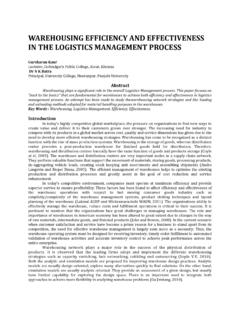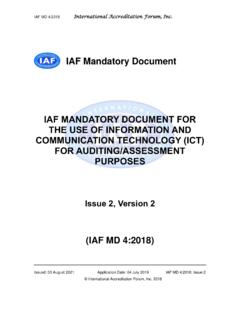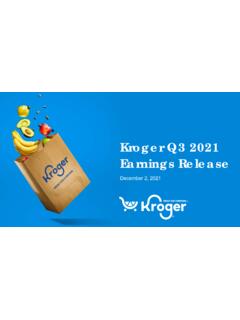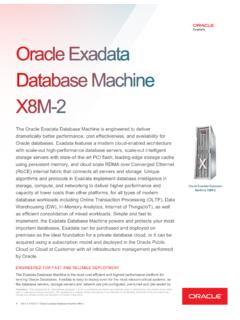Transcription of Data Governance for Financial Institutions
1 Data Governance for Financial InstitutionsDrivers and metrics to help banks, insurance companies and investment firms build and sustain data governancethe way we see itFinancial ServicesThe information contained in this document is proprietary. 2013 Capgemini. All rights reserved. Rightshore is a trademark belonging to of Contents1. Introduction 32. Starting a Data Governance Initiative Common Business Drivers Showing the Value 43. Quantifying Success with Data Governance Metrics Examples of Business and IT Metrics 74. Sustaining a Governance Program 95. Conclusion 11 Table of ContentsFinancial services organizations are built on data, so data Governance is a critical concern. But many firms have their own definition of data Governance which may be completely different from competitors.
2 For some Financial Institutions , data Governance means establishing Governance bodies and councils, while others consider data Governance the process of defining data stewardship and workflow. Some Financial services firms have master data management and data quality programs established under the name of data Governance , while others combine all of these aspects Governance bodies, data stewardship, metadata and master data management and data quality under the data Governance umbrella. Theoretically, data Governance encompasses the systematic and formal management of any service or process that is required for effective information management. But realistically, businesses prioritize and sponsor only those initiatives that are mandated by regulations or provide a clear return on investment.
3 The Financial services industry has been moving towards enforceable data Governance which turns static policies and standards in Word documents into Governance processes that can be enforced and realized in IT and the business with tangible benefits. Within Financial services firms, the most prominent Governance goal is the availability of reliable and accurate data for risk aggregation and reporting including data accountability and the world, regulatory bodies and committees have published principles and guidelines on data management, maintenance and Governance for risk aggregation and reporting. In Canada, the Office of the Superintendant of Financial Institutions (OSFI) has published data maintenance principles for Institutions following the International Ratings-Based (IRB)approach.
4 Similarly, The Bank of International Settlements (BIS) has published principles of effective risk data aggregation and risk reporting. Similar guidelines were released by the Financial Conduct Authority in the as part of BIPRU. As with most Financial releases, these principles contain broad guidelines on data Governance and management and it can be difficult and costly to implement recommendations based on interpretations. Although IT enables and implements tools for data Governance , it is not an IT initiative and should not be driven by IT. For a data Governance program to be successful and sustainable, the mandate must come from the business. While a data Governance program may result in a tool-based implementation, that is not the core of data essence, the business drivers provide direction and steer the initiative; IT objectives drive the plan for execution; and IT technical implementations are the final deliverables.
5 This can be described as: Business drivers steer IT objectives resulting in technical Introduction3the way we see Common Business Drivers For Financial services organizations, the most common reasons for a data Governance initiative are: Support risk management and regulatory reporting Address mergers, acquisitions and divestitures Provide improved analytics to gain competitive advantage Enable more informed and real-time decision making Save or avoid costs Assist with cross and up-selling Comply with regulations Reduce customer attrition Enhance customer service quality Improve profitability and operational effectivenessFinancial stakeholders may have one or more business drivers as a goal. How do multiple drivers impact an IT organization? IT should align objectives to meet all the identified goals.
6 The exhibit illustrates how business drivers can map to IT objectives and the resulting technical implementations. Note that one business driver may lead to several IT objectives, and one IT objective may be the result of multiple business Showing the Value After the initial effort, stakeholders and business sponsors often struggle to show the value of sustained data Governance programs since ongoing cost-benefits and return on investment can be difficult to quantify. While regulatory and compliance needs are compelling reasons to sustain a data Governance program, other data Governance drivers may be lower priority for the enterprise and result in reduced budgets and waning stakeholder interest. Managing expectations from a data Governance program takes effort which can be significantly minimized by using quantifiable key performance indicators (KPIs) and metrics.
7 Governance goals such as effective use of business intelligence tools or improved business-IT collaboration are difficult to quantify and unlikely to result in a long-term data Governance program. 2. Starting a Data Governance Initiative4 Data Governance for Financial InstitutionsExhibit 1: Business drivers steer IT objectives resulting in technical implementationsSource: Capgemini Analysis, 2013 Business DriversRisk Management & regulatory ReportingIncrease revenue Growth modelMergers, Acquisitions & Spin-offsCost savings/ cost avoidanceReduce customer attritionCompliance AdherenceEnable smarter business decisionsBetter analytics & Increased market competitivenessCross selling/ up sellingImprove customer service qualityIT ObjectivesSingle version of Truth360 Customer viewImproved data qualityBusiness SemanticsTraceability & AuditabilityArchitectural StandardizationOwnership & AccountabilityInformation & Resource rationalizationImproved Business- IT collaborationImproved operational efficiencyTechnical ImplementationsMDM/CDMCRM Data Quality ProgramDMO programTaxonomy/ OntologyMetadata managementMetadata managementDMO ProgramCommon architectureCommon tool stacksTool standardizationData Stewardship.
8 Ownership Governance workflows Data Lineage & traceabilityCommon ArchitectureFine tune processesData Stewardship, Business-IT workflows and DMO ProgramRight information at the right timeBetter IT performance Performance tuningResult inSteer5the way we see itA long-term, sustainable data Governance initiative must be built on a foundation of metrics based measurements. These metrics can be broadly classified in three categories: efficiency metrics Enablement metrics Enforcement metricsFinancial services firms must make sure the costs and effort associated with implementing, managing and maintaining a data Governance program address these three aspects by answering these key questions: 1. How does a data Governance program help improve the effectiveness of your firm? efficiency 2.
9 What does a data Governance program allow your institution to do now that could not be done before? Enablement 3. How does a data Governance program help impose corporate mandates and standards? Enforcement If there are quantifiable metrics around efficiency , enablement and enforcement, data Governance can be effectively Quantifying Success with Data Governance Metrics6 Data Governance for Financial Examples of Business and IT MetricsBelow are examples of common Governance metrics for Financial services firms. This list is not comprehensive but provides a preview into business and IT metrics spread across topics. Financial Institutions should adopt metrics that are relevant to the required drivers and planned IT 2: Business Metrics ExamplesMetricEfficiencyEnforcementEnabl ementTimely regulatory reporting adherence Cross selling/up selling results from improved data Governance and consolidated customer view Customer attrition report before versus after Accuracy and timeliness of risk calculations and aggregations Quantity and business analyst time spent on data collection and preparation versus time spent on analysis Critical data and processes with ownership defined (%) Business processes with RACI defined (%)
10 Metrics on data quality, , accuracy, reliability, redundancy, completeness, conformity, integrity Key data elements with issues, , no definition, duplicate definition Auditability report which lists how many critical elements can be audited and traced and how many cannot Reduction in total cost of ownership for programs under data Governance umbrella New customer retention rates M&A cycle time before and after M&A-related incidents reported, Integration issues reported Increase in market share before versus after (%) Reduction in time spent in manual adjustments and reconciliations (%) Overall reduction in IT spend due to information and resource rationalization 7the way we see itExhibit 3: IT Metrics ExamplesMetricEfficiencyEnforcementEnabl ementMetrics on data quality, , accuracy, reliability, redundancy, completeness, conformity, integrity Architectural conformance percentage across projects compliant versus non-compliant Conformance to enterprise data models and semantic models Conformance to data management standards , naming standards, reusability percent levels Resource staff that could be reduced as a result of Governance initiatives (%) Infrastructure that could be eliminated, reduced, standardized as a result of Governance initiative (%) Critical data and processes with ownership defined (%) IT processes with RACI defined (%) Key data elements with no lineage and traceability captured (%)
